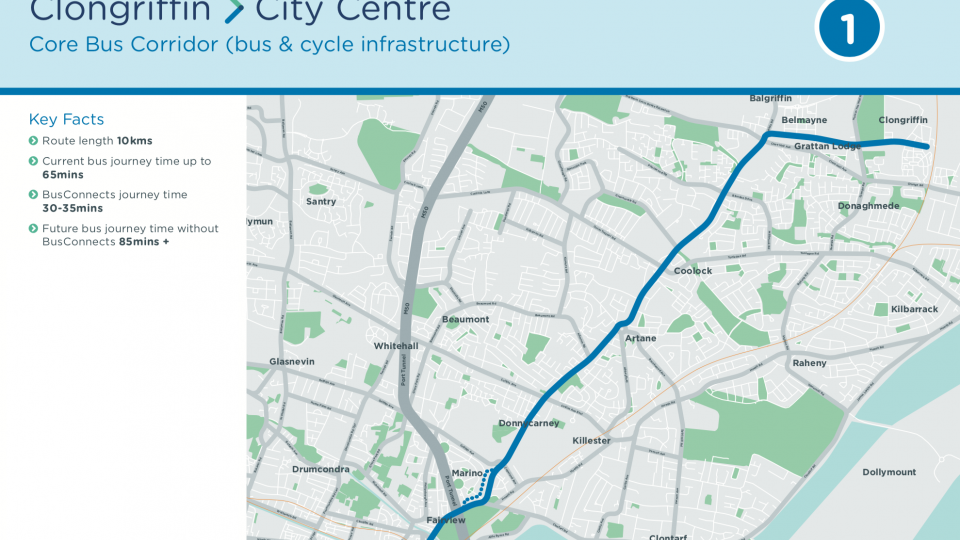Core Bus Corridor 1: Clongriffin
Overall the Clongriffin Core Bus Corridor (CBC) is good-quality, especially compared to the other CBCs. The route follows the Malahide Road from Clarehall to Marino. If the current proposals were built it would be a large improvement on what exists today. However, it falls short of the standards in the NTA’s own National Cycle Manual. We need your help to create a cycle route suitable for people of all ages and abilities.
The positives first. The proposals would:
- Deliver 5km of good quality cycle track from Clarehall to Marino. From there it joins into the planned high-quality North Strand cycle route to the Liffey
- Remove the pedestrian and cyclist hostile roundabouts
- Remove eleven slip lanes. Slip lanes encourage motorists to take corners at speed, which is exactly the place where they should be slowing down
- Add four new pedestrian crossings
- Include 23 cycle bypasses of the 30 bus stops
However, the Dublin Cycling Campaign has identified serious issues along the route.
Many of the junction designs are completely unsafe. They include “orphaned cycle lanes” with a traffic lane on either side. This leaves cyclists over-exposed to motor vehicles turning across a painted cycle lane, which are up to 75m long. This design is banned by the National Cycle Manual. For the larger junctions the NTA should use a design that fully segregates cyclists from traffic. This would require keeping cyclists left at junctions and giving them their own traffic lights separate from traffic.
On roads like the Malahide road, the NTA’s National Cycle Manual requires a buffer space between the cycle track and the road, normally a grass verge. This increases safety and comfort levels for cyclists.
The NTA is proposing to divert cyclists through residential streets in Marino. In principle this is a good diversion for cyclist leaving the city. Many cyclists already use this shortcut to avoid the main road. However, for cyclists heading into the city it is a poor option.
The NTA undertook a study for this area. They found that diverting cyclists was the preferred option. We have found three issues with this study. A cycle track heading into the city should have been the preferred option based on their NTA’s study, but it was not. This study must be repeated.
The Dublin Cycling Campaign has identified many other issues, which are included in our draft submission linked at the end.
We need you to make a submission to the NTA. Otherwise these proposed concept designs could quickly become the final design. A submission is a short piece on how the NTA should change their proposals.
Some advice for writing a useful submission:
- Keep it short and personal
- Tell the NTA why this Core Bus Corridor affects you. Do you live nearby or cycle this route often? Mention that.
- Tell the NTA why you want to see changes. For example, if the junctions were safer would you let your kids cycle to school?
- Describe some of the cycle trips you take along this route
- Include some of the Dublin Cycling Campaign’s key issues
Our key issues:
- Enabling cycling for all ages and all abilities should be the aim
- The junctions should segregate cyclists instead of mixing them with traffic
- A buffer zone between the cycle track and the road should be added
- The Marino cyclist diversion should be re-analysed
- All bus stops should have cycle bypasses
- The cycle track should be inside of on-street parking
Make a Submission
Now that you’ve made your submission please spread the word to your friends and family. Without many voices demanding better cycle facilities the NTA will build the current proposals.
If you want to be kept up-to-date on BusConnects subscribe to our BusConnects email newsletter. We’ll email you updates on the corridors your interested in.
Help us do more for cycling in Dublin by becoming a member!

